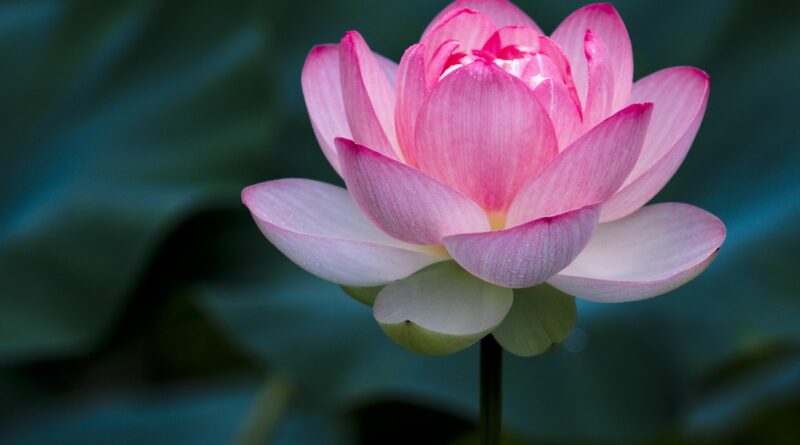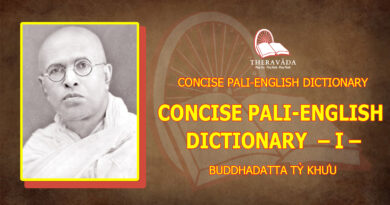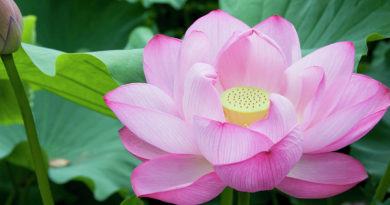Answers By Mr. S. N. Goenka: Concentration (samadhi)
MAIN CONTENT
- What is the difference between Vipassana and concentration?
- Why do we observe only the breath?
- Why do you give so much importance to the observation of normal respiration?
- Why do you want us to keep our attention at the entrance of the nostrils and above the upper lip while practicing Anapana?
- Why should we work with respiration only?
- How is equanimity related to samādhi (concentration of the mind)?
- You have asked us to live in the present. Does this imply that we should not plan for the future at all? Does it mean that we should not be ambitious?
- How can the observation of breath assist in practising the moral precepts (sila)?
- What is the mind?
- Who reforms the mind?
- How can Anapana help to reform the mind? How can Anapana lead to purity of mind?
- You say we are meditating to sharpen the mind. How do we sharpen the mind?
What is the difference between Vipassana and concentration?
Mr. S. N. Goenka: Vipassana is not merely concentration. Vipassana is observation of the truth within, from moment to moment. You develop your faculty of awareness, your mindfulness. Things keep changing, but you remain aware – this is Vipassana. But if you concentrate only on one object, which may be an imaginary object, then nothing will change. When you are with this imagination, and your mind remains concentrated on it, you are not observing the truth. When you are observing the truth, it is bound to change. It keeps constantly changing, and yet you are aware of it. This is Vipassana.
Why do we observe only the breath?
Mr. S. N. Goenka: Because it will eventually pave the way for Vipassana. Breath is a true fact. It is the truth that is closely associated not only with our body but also with our mind. Like a scientist, we have to diligently discover the truth about ourselves, our body and mind. Moreover, this knowledge should be based at the experiential level and not on what we are told or study in books, etc. We have started this practice of observing the breath, so that we can learn the truth about ourselves. This will enable us to get rid of our faults on the one hand and conserve and expand our virtues on the other. All this is possible only if we know our minds, and the mind can be known through the breath. We are observing the breath; and in the process, we begin to know our mind. While learning about the mind we can also reform it. Thus, the mind and respiration are closely linked. This will become more evident as you progress on the path of meditation. While observing the breath, some angry thoughts may occur in the mind. You will notice that the normal pace of the breath gets disturbed and it becomes fast and heavy. And the moment the mind gets rid of anger, the breath becomes normal. This shows how the disorders of the mind are related to our breathing process. As you meditate further, you will understand all this better. But you will only understand this phenomenon clearly if you work with the pure breath. If you add anything to the breath, then you will fail to grasp all this. For these reasons, we work with the breath. Respiration is related not only to the body but to the mind as well. When we breathe in, the lungs get inflated with air and when we breathe out, the lungs are deflated. This is how the respiration is related to the body. And as it was just explained, if an impurity arises in the mind, the normal pace of the breath gets disturbed. This is how respiration is related to the mind.
Why do you give so much importance to the observation of normal respiration?
Mr. S. N. Goenka: Because the Buddha wanted you to. He is very clear that one must observe the breath as it is-yathabhuta. If it is long, you are aware, “it is long”; if it is short, you are aware, “it is short”. Yathabhuta. If you make your respiration unnatural, artificial, you will give more attention to change the respiration according to your wishes. Your attention will not be with the reality as it is, but with something that you have created.
Therefore, we emphasize it must be always natural breath-as it comes in naturally, as it goes out naturally. If it is long, just be aware that it is long. Don’t try to make it short. If it is short, just be aware that it is short. Don’t try to make it long. If it is going through the right nostril, then observe that it is going through the right nostril. If it is going through the left nostril, then observe it through the left nostril. When it passes through both the nostrils, observe the flow through both the nostrils.
Then you are working according to the instructions of the Enlightened One. Don’t try to interfere with the natural flow of the breath. And if you find that the mind is wandering too much and you cannot feel the natural breath, then you may take a few-only a few-intentional breaths, slightly hard breaths, so that you can bring your mind back to the observation of the breath. You have to keep in mind that your aim is to feel the natural breath. However soft it is, however subtle it is, you must be able to feel it. That is the aim.
Why do you want us to keep our attention at the entrance of the nostrils and above the upper lip while practicing Anapana?
Mr. S. N. Goenka: Because again, it is a very clear instruction given by the Enlightened One. In Patisambhidamagga, he clearly says that you must be aware of the incoming breath, the outgoing breath, and mukha-this area above the mouth. He calls it mukhanimitta. It is clearly explained in Patisambhidamagga and in Vibhanga, what is mukhanimitta: it means nasikagge, the front portion of the nose at the entrance of the nostrils. Also, the Buddha says that it must be Uttarotthassa majjhimappadese. Uttara means above; ottha is lip; and majjimappadese is the middle portion. And in the Mahasatipatthana sutta, he says, establish your awareness here, parimukham satim upatthapetva. Sati means awareness; parimukham means the area above the lips.
The Buddha is so clear in his instructions. We cannot deviate from his instructions. And as you practice, it becomes very clear why the Buddha chose this small area. This is the area over which the incoming breath and the outgoing breath must pass. The incoming and outgoing breath touches the area at the entrance of the nostrils and above the upper lip. That is why he wanted you to keep your attention here. For those with long noses, the breath is likely to touch the entrance of the nostrils. For those with short noses, it usually touches the area above the upper lip. So he chose this area-either at the entrance of the nostril, nasikagge, or the middle part of the upper lip.
The Buddha does not want us to imagine that the breath is coming in or the breath is going out, you must actually feel it. When you are attentive, you can feel its touch somewhere in this area.
For a very new student, we say even if you feel the breath inside the nostrils, it is okay. But ultimately you have to be aware of the touch of the breath in this area. Why? Because for samadhi, concentration of mind, citta ekaggata [one-pointedness of the mind] is very important. For a new student, a bigger triangle including the whole area of the nose is okay. But within a day or two, the student is asked to observe a smaller area. It becomes very clear, as you keep on progressing on the path given by the Buddha, that the area of concentration must be as small as possible.
It also becomes clear that the object of concentration must be very subtle. That is why when the mind is wandering too much, you are allowed to take a few hard breaths, but after that, you must come back to the natural breath. And as your mind gets concentrated, the breath will become softer and softer, finer and finer, shorter and shorter. You won’t have to make any effort. It happens naturally. Sometimes the breath becomes so short, so fine, like a thin thread, that it feels as if immediately after coming out it makes a U-turn and enters the nostrils again. So when the area is small, the object of concentration is very subtle, and you continue without interruption, the mind becomes very sharp.
The Buddha was sabbaññu-he knew everything so clearly. There is an important nerve centre in this area. When your mind is sharp and you are aware of this area, your mind becomes so sensitive that you start feeling some sensation in this area. The purpose of Anapana, the purpose of samadhi, is to take the next step of Vipassana. Vipassana is not Vipassana if you don’t feel sensations.
Therefore, he taught us in a very systematic manner. Start on a small area with the natural breath. The breath will become subtler and subtler; the mind will become sharper and sharper. This area will become very sensitive and you will start feeling sensations. Everywhere around the world, people coming to the courses and practicing the technique given by the Enlightened One, start feeling sensations in this area on the second or third day. The Buddha taught the technique, the path, very systematically. We don’t want to deviate from what he taught.
Coming back to the first question of why we work with the natural breath-there are other techniques especially in India where one controls the breath, for example, the technique of Pranayama. One takes a deep breath and stops for some time; one exhales and stops for some time. We don’t condemn other techniques. We understand that Pranayama is good for physical health. But the Buddha wanted us to use the awareness of the natural breath to reach the next step of feeling sensations. This controlled breathing, Pranayama, is not suitable because it is artificial breath.
Buddha wanted us to observe natural breath because it takes us to the stage where we can practice Vipassana. Those who want to practice Pranayama for health reasons, let them practice it separately. Don’t connect it with Vipassana. When you practice Vipassana, natural breath is important, yathabhuta, as it is.
Why should we work with respiration only?
Mr. S. N. Goenka: Respiration is the truth. Respiration is related to your mind and matter, and you are here to make an analytical study of mind and matter. So you start with respiration, and then go to a deeper level of mind and matter.
Mr. S. N. Goenka: Samādhi can be without equanimity. With the base of craving one becomes fully concentrated. But that kind of samādhi is not right samādhi. That is with the base of impurity. But if the samadhi is with equanimity, then it gives wonderful results, because the mind is pure and concentrated, so it is powerful with purity. It cannot do anything that will harm you or harm others. But if it is powerful with impurity, it will harm others, it will harm you. So equanimity with samādhi is helpful.
You have asked us to live in the present. Does this imply that we should not plan for the future at all? Does it mean that we should not be ambitious?
Mr. S. N. Goenka: These are two different questions, and quite relevant as well. It is certainly not wise to live in the present and not think about the future at all. While observing the breath, you are also gaining awareness of the workings of the mind. You have observed that it has become a permanent habit of the mind to always generate thoughts about the past or the future. The mind does not want to focus on its present task of observing the breath. When it is involved in thoughts of future, the mind’s energy gets reduced and therefore it is unable to work with full potential on the task at hand. And, when the actual time for taking the right action comes, the mind has exhausted all its energy. So with the mind firmly rooted in the present, think and plan the immediate task at hand. Set your goal and keeping it in sight, walk step by step towards it. Once the goal is set, you should not think about it any more. This way, every step you take will be a step in the present. But remain aware of each and every step you take. This will eliminate all possibilities of making mistakes.
You may wonder how you will be able to lead your life if you do not plan for the future. We have a limited reservoir of energy and therefore it should be utilized with wisdom. We should only use as much as is required for planning the future. We tend to exhaust our energy by unnecessarily tormenting the mind with thoughts of the future. “This may happen or this may not happen. We may do this or we may not do this?” Oh! Indulge in all this thinking only when it is required. Right now, your job is to observe the breath so that you learn to remain in the present. If we adopt the habit of remaining firmly in the present, we will be able to take the next step properly. Thus, to establish this habit pattern of the mind, we emphasize staying with the present.
To be ambitious is not bad at all. We set a definite aim for our life. For instance, we study to fulfil a certain ambition, or we are doing meditation for a certain purpose. But if we get attached to our goal and constantly worry about it while making no efforts to attain it, then it is futile to have any ambition. What is the point in being ambitious about a thing which prevents you from taking the right course of action? Decide about your aim and then strive to achieve it. If you are thirsty, then go and get water. Merely crying for water and worrying about it will not quench your thirst. Make the desired effort to obtain water, drink it and satisfy your thirst. What is wrong with this? Similarly, there is no harm in having a good ambition and making efforts to attain it. But if you get obsessed with it and only worry about its fulfilment without making any efforts in that direction, then you will go off the track and fail- even a good ambition will not be successful. So have the right ambition and strive hard to attain it.
How can the observation of breath assist in practising the moral precepts (sila)?
Mr. S. N. Goenka: This is indeed a good question. If the observation of breath does not help us to preserve morality and establish ourselves in Dhamma, then it is a futile exercise. This technique will be very beneficial in living a good life. If we continue to observe the natural flow of respiration, we will find that it helps us to gain control over our mind. Our mind will not be as weak and restless as before. Its ability to concentrate will improve. The more it concentrates, the stronger and wiser it gets. Its faculty of awareness improves. If anger arises in the mind, it will instantly become aware of it. Then all you have to do is to observe the respiration. A few minutes of observing the breath will eliminate anger from the mind. Earlier, when we were in a bad mood, we used to either abuse the other person or we would lose control and hit him, thus breaking our sila. So Anapana has prevented us from doing a harmful deed. Any wrong act we perform defiles the mind, and the person practising Anapana immediately becomes aware of this. The only way to get rid of the impurity is to observe the breath for some time. If we continue to observe the breath, the impurity will be removed and we will be saved from breaking our sila.
What is the mind?
Mr. S. N. Goenka: The mind is what thinks! The entire thought process is due to the mind. It is the mind that is constantly involved in the various actions of thinking, reading and pondering over what has been read, etc. During its course of thinking, the mind may act beneficially or harmfully. If it adopts the wrong habit pattern, then it will generate feelings of ill will and animosity for others. If instead, the mind reforms itself, then although it will still have thoughts they will now be thoughts for the well being of others. If someone has shortcomings, the mind will want that person to overcome his shortcomings because now the mind knows that due to his shortcomings, that person will perform wrong actions which will make him more miserable and unhappy. So the mind will harbour thoughts of goodwill towards that person. It will want the person to refrain from doing bad deeds and thus save himself from burning in the fires of suffering. We observe that it is the nature of the mind to generate thoughts all the time. Therefore, our most important duty is to guide the mind towards a healthy thought process and prevent it from taking the path of unhealthy thinking patterns. Our entire effort is aimed towards understanding this nature of the mind and correcting it if it goes on the wrong path.
Who reforms the mind?
Mr. S. N. Goenka: It is the mind that reforms itself. A part of the mind is always observing its own functioning. If there are thoughts in the mind, it will analyse the nature of these thoughts. Whenever negativity or a feeling of animosity arises in the mind, this same part instantly issues a warning that such negative emotions are undesirable and should not occur in the mind. This part may be called intellect or the part of the mind which is always alert regarding the functioning of the mind and is trying to reform it. If the mind can develop the habit of observing the truth as it appears, then this fact will become clear- that the moment the mind is defiled, it is punished with suffering; and if it is purified, the suffering is removed. It is this observing part of the mind which will understand this process and thus change itself. Nobody wants to remain agitated. Everyone wants to lead a happy life without miseries. To attain this state, the observing part of the mind tries to change the nature of the remaining part of the mind.
How can Anapana help to reform the mind? How can Anapana lead to purity of mind?
Mr. S. N. Goenka: As long as the mind is engaged in doing Anapana, that is, in the observation of the flow of respiration, it is without any thoughts, and as a result of this, it is without any defilements. It is our thoughts which defile the mind. Mostly while we are thinking, there is craving or aversion. Pleasant thoughts generate craving and unpleasant thoughts generate aversion. But when we are observing the incoming and outgoing breath, there is no reason for us to generate either of these emotions and so these are moments of purity in the mind. More and more of these moments of purity will reverse the habit pattern of the mind. The mind that was previously generating impurities will now become pure. This transformation, which initially takes place at the surface level of the mind, will gradually take deep roots as you progress on the path of Vipassana.
You say we are meditating to sharpen the mind. How do we sharpen the mind?
Mr. S. N. Goenka: If you are with the reality and not reacting to it, naturally the mind gets sharpened. The mind gets blunt when it reacts, more and more reaction makes the mind very gross. When you don’t react, its natural reality is very sharp, very sensitive.
Source: https://www.vridhamma.org







